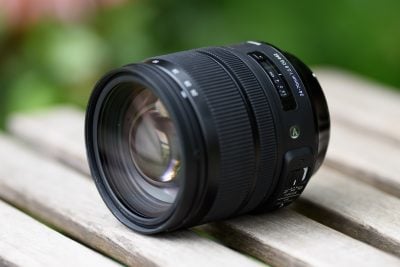Sigma 24-70mm f2.8 OS Art review
-
-
Written by Thomas
In depth
The Sigma 24-70/2.8 OS Art is a stabilized standard 2.9x zoom available in mounts for Canon, Nikon and Sigma DSLRs with full-frame sensors and can also be used with Sony E-Mount bodies using Sigma’s MC-11 mount converter.
Announced in February 2017 it is the long awaited successor to Sigma’s non-stabilized 24-70mm f2.8 from 2008 which seems to be no longer available. As you would expect from any new Sigma lens it is compatible with their USB-dock to fine tune various characteristics of the AF, plus if you change bodies, you can pay to have the mount swapped for your new system. The inclusion of this lens in Sigma’s “Art” line indicates a top-notch optical design which unfortunately also brings with it a hefty price: 1300 USD / 1450 EUR list-price is a mark-up of almost 100% over the last street-price of its predecessor.
To find out how the new Sigma 24-70mm f2.8 OS Art performs I tested it against Nikon’s own 24-70mm f2.8E VR on the demanding D810 body. So if you’re shopping for a large aperture full-frame standard zoom, you’ve come to the right place!
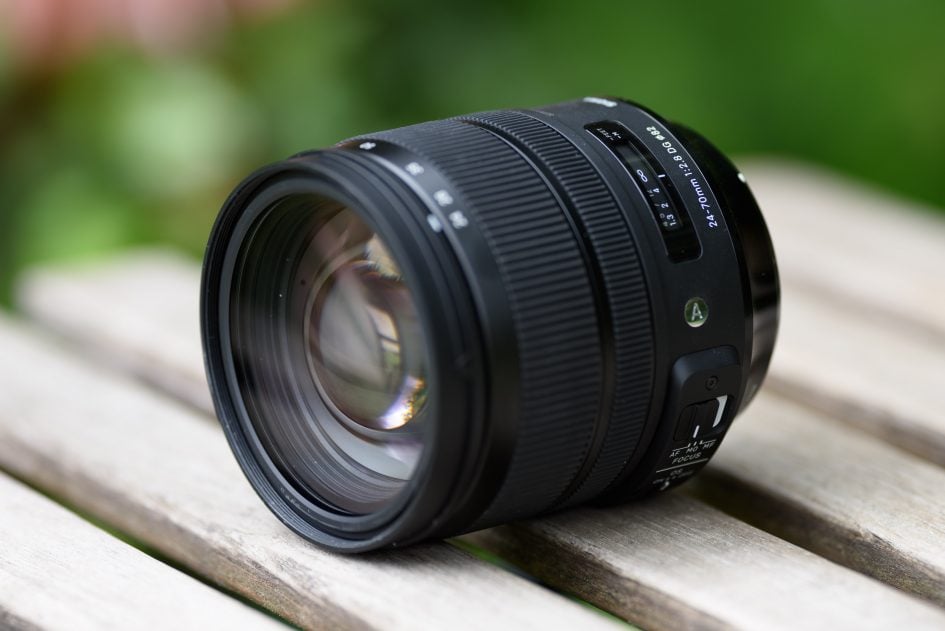
Facts from the catalog
As usual I’ll have a look at the technical data of the Sigma first. I’ve rated the features with a [+] (or [++]), when it’s better than average or even state of the art, a [0] if it’s standard or just average, and [-] if there’s a disadvantage. For comparison I use the Nikon 24-70mm f2.8E VR (“Nikon” for short) and the Sigma AF 24-70mm f2.8 EX DG HSM (“predecessor”).
Size (diameter x length): 88 x 105mm (3.5 x 4.1 in.), the lens hood adds 36mm (with a diameter of 101mm). Zooming out adds another 31mm which gives a total maximum length of 172mm. The zoom cannot be locked – just like any other 24-70mm zoom. The predecessor was 89 x 95mm. The Nikon is 88 x 203mm with lens hood attached but does not get longer with zooming. [0]
Weight: 990g (35 oz.) plus 35g for the plastic lens hood. The predecessor was 790g while the Nikon is 1068g with the lens hood adding another 60g. [0]
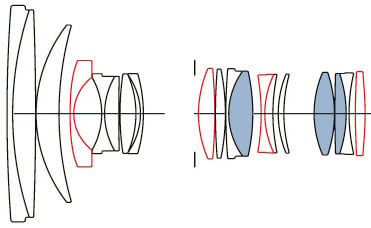
Optics: 19 elements (including 3 special dispersion and 4 aspherical elements) in 14 groups vs. 14 elements in 13 groups for the predecessor and 20/16 for the Nikon. 14 groups have 28 air/glass surfaces that produce a lot of opportunities for flares and ghosts. We’ll see how this works out in practice. [0]
Closest focus distance is 0.37m (1.2 ft.) with a magnification of 1:4.8. This is a little better than the predecessor. The Nikon achieves 1:3.1 magnification in manual focus. [0]
Filter-thread: 82 mm, just like the predecessor and the Nikon. This is larger than the de facto standard of 77mm, so you might need new filters. [0]
Image stabilization: Yes, Sigma finally caught up with the competition. This is indispensable when handholding at long focal lengths. But there are no different modes of stabilization and no option to customize the OS operation via the USB-dock. [+]
Auto focus: HSM (Hyper Sonic Motor), so it also works on camera bodies which don’t have an AF-drive built in like Nikon’s D3x00/5×00. Manual-focus in single-servo AF (AF-S) override is by simply turning the focus ring. Same with the Nikon and the Canon. If you want manual override in continuous-servo AF (AF-C) you need to switch focus mode to MO. The new Sigma allows you to alter focus fine-tuning at 4 distances and 4 focal lengths with the USB-dock. [+]
Covers full frame/FX or smaller = very good. Same with the competition. [+]
Price: around 1450 EUR (incl. 19% VAT) / 1300 USD. That’s a hefty price compared to current street-price of its predecessor – if you still can find one. But the Nikon goes for around 2100 EUR and the newly announced Tamron 24-70/2.8 VC G2 (expected in August) has a list-price of 1700 EUR. [0]
Comes with a nice semi soft lens-case but no strap. The lens hood is included, reversible for transport, and the lens-caps are standard. When using the onboard flash of the D810 the lens hood casts a shadow at the bottom of the image between 24mm and 50mm focal length. Without lens hood there is only a slight shadow at 24mm. [0]
Distance information is relayed to the camera, so the camera and flashes can do all the advanced exposure-related stuff with this lens. Same for the competition. [+]
Aperture ring: no, same as with the competition. The aperture is actuated electromagnetically in the Nikon-version too which makes it the equivalent of a modern E-type Nikon lens and puts away with the mechanical coupling that Nikon uses on all older lenses. [0]
Sealing: yes, a rubber grommet at the lens-mount but no further special weather-sealing. The Nikon has additional sealing towards the lens-cap and throughout the lens. [+]
The score in the “features-department” is 0[-]/8[0]/5[+]. So the lens is well-featured. Had I included the option to get the lens-mount swapped the lens would score another [++] as this is a unique feature that no other manufacturer offers.
Two standard zoom lenses
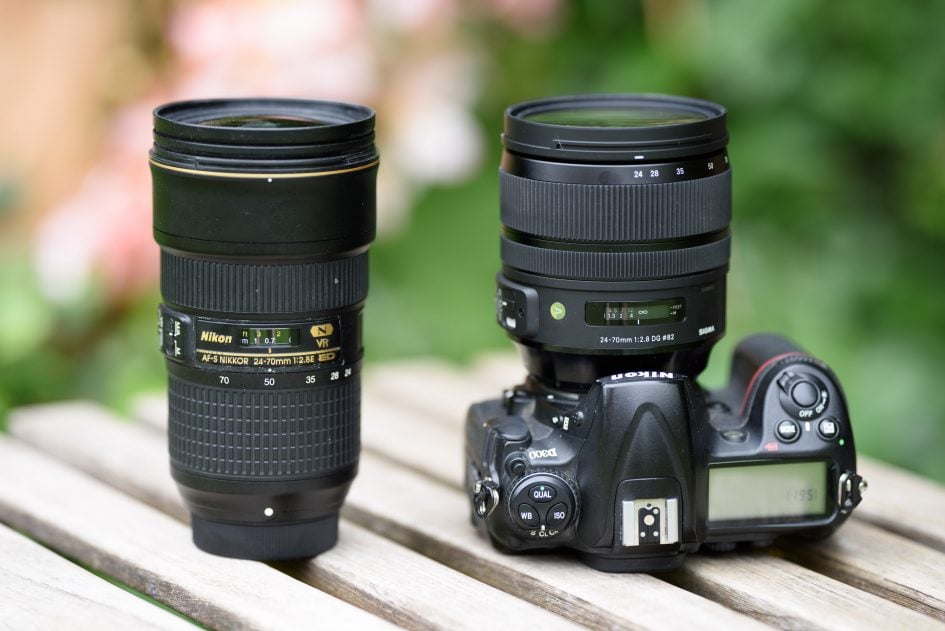
Above left: Nikon 24-70mm f2.8E VR, above right: Sigma 24-70mm f2.8 OS Art
Alternatives:
- Canon users can get the EF 24-70mm f2.8 II L USM from 2012. It has no image stabilization and costs around 1800 EUR.
- Nikon has the AF-S 24-70mm f2.8E ED VR from 2015. It’s stabilized and costs around 2100 EUR and its optical performance earned it a Highly Recommended. See my Nikon 24-70/2.8E VR review.
- Sony offers different versions of a 24-70mm f2.8 zoom but their latest is the FE 24-70mm f2.8 GM. The lens does not offers its own image stabilization so you need to rely on the built-in stabilization featured in some Sony bodies. It is sold for around 2060 EUR.
- Tamron has the stabilized SP AF 24-70mm 2.8 Di VC USD from 2012 costing around 820 EUR. It was the first stabilized 24-70mm f2.8 zoom and earned a Recommended rating in my Tamron 24-70mm f2.8 VC review. A second generation (“G2”) version of this lens is expected to hit the streets in August.
- Tokina offers the AT-X Pro 24-70mm f2.8 FX from 2015 for around 900 EUR. It has no image stabilization.
Here is the angle of view that the new Sigma 24-70mm covers with its 2.9x zoom:

Above: Sigma 24-70mm f2.8 OS Art coverage on Nikon D810 (FF/FX) body at 24mm (left) and 70mm (right)
Focus and zoom
Focus accuracy and repeatability is critical to consistently produce sharp shots. Repeatability (the accuracy of focus on the same subject after repeated focus-acquisition) of this lens at standard settings and 70mm focal length is pretty good (measured 98.4% in Reikan FoCal) with 3 mild outliers over a series of 40 shots. And I’ve seen this in real life too where some shots were simply not focused optimally. There is a little performance variation whether the lens focuses from infinity or from a closer distance. At 50mm focal length the lens focuses without hunting in around 0.35sec from infinity to 0.5m, which is very fast. The Nikon 24-70/2.8E VR also needs 0.35 sec, has a repeatability of 98.9%, and had no outliers in 40 shots under the same test conditions.
The focus ring has no slack/play between its movement and the focus-action and a throw of 80 degrees. Its rubberized surface is only 10mm wide. The zoom ring turns through 65 degrees and has a 22mm wide rubber surface. Both rings are pretty stiff and can hardly be turned with one finger. They turn both in the same direction as Canon users are used to but this is the complete reverse of what Nikon does. The zoom ring is at the front and the focus ring closer to the camera – also reverse to what the Nikon has.
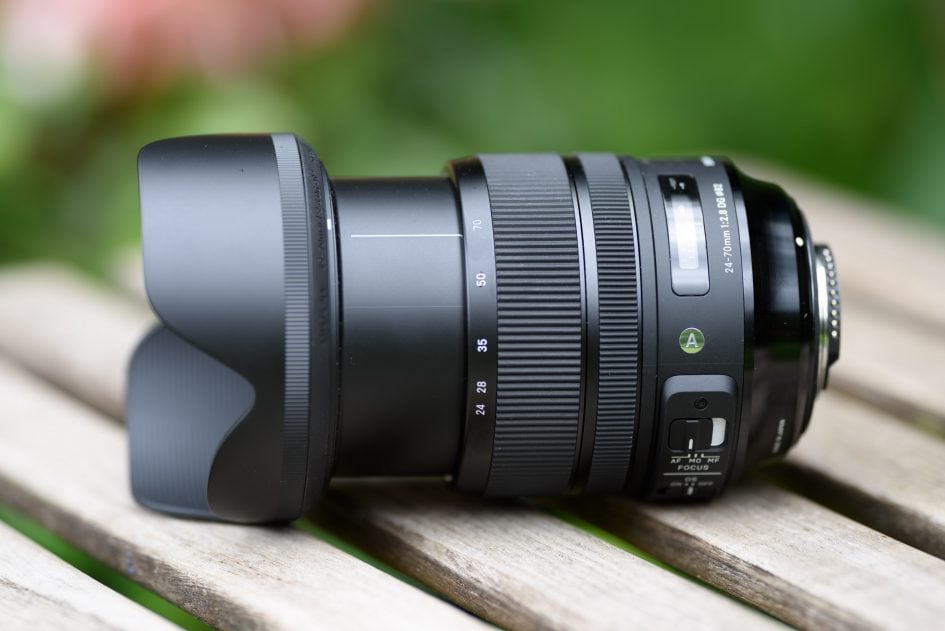
AF-operation is barely audible from the outside, and if you record video with the built-in microphone the AF-drive produces no clicks at the start or stop of focus-movements. But there seem to be two drive-modes during a contrast based focus operation: in slow mode noise is very low while in high-speed mode the camera records a noticeable hiss. The image stabilization is virtually silent both on the outside and when recording video.
As you pull focus, you’ll notice some focus breathing: the image becomes less magnified at closer focusing distances. When I adjusted the focus from infinity to 0.7m on the Sigma, I measured a 8% decrease in magnification at 70mm focal length which is pretty visible and may disturb videographers. In comparison the Nikon 24-70/2.8E VR enlarges the image by 2%.
Image stabilization
To test the effectiveness of the image stabilization I did a series of 140 test-shots hand-held with the new Sigma at 70mm focal length. I tested with shutter speeds from 1/80 of a second down to 1/2.5 sec. Shots at 1/80 sec with OS=Off are used as reference of how good my hand-holding was at the time of the test and Reikan FoCal did the chore of evaluating the sharpness of all shots. All-in-all the results are very convincing. Here’re the details: at 1/80 sec, 1/40 sec and 1/20 sec OS has a clear advantage over OS=Off at 1/80 sec. At 1/10 sec and 1/5 sec (3 and 4 stops) the results tended to become a bit more erratic but were on average still similar to those at 1/80 and OS=Off. Only at 1/2.5 sec (5 stops) the chances to get a usable image sank below 50%. So that’s a good 4 stops of stabilization.
Btw.: The lens does not offer different stabilization modes. Judging from the stabilization of the viewfinder-image Sigma gave priority to the stabilization of still-images which is fine for photogs. But live-view and video capture seem to profit not as much from OS.
Next check out my quality results!
Check prices on the Sigma 24-70mm f2.8 at Amazon, B&H, Adorama, or Wex. Alternatively get yourself a copy of my In Camera book or treat me to a coffee! Thanks!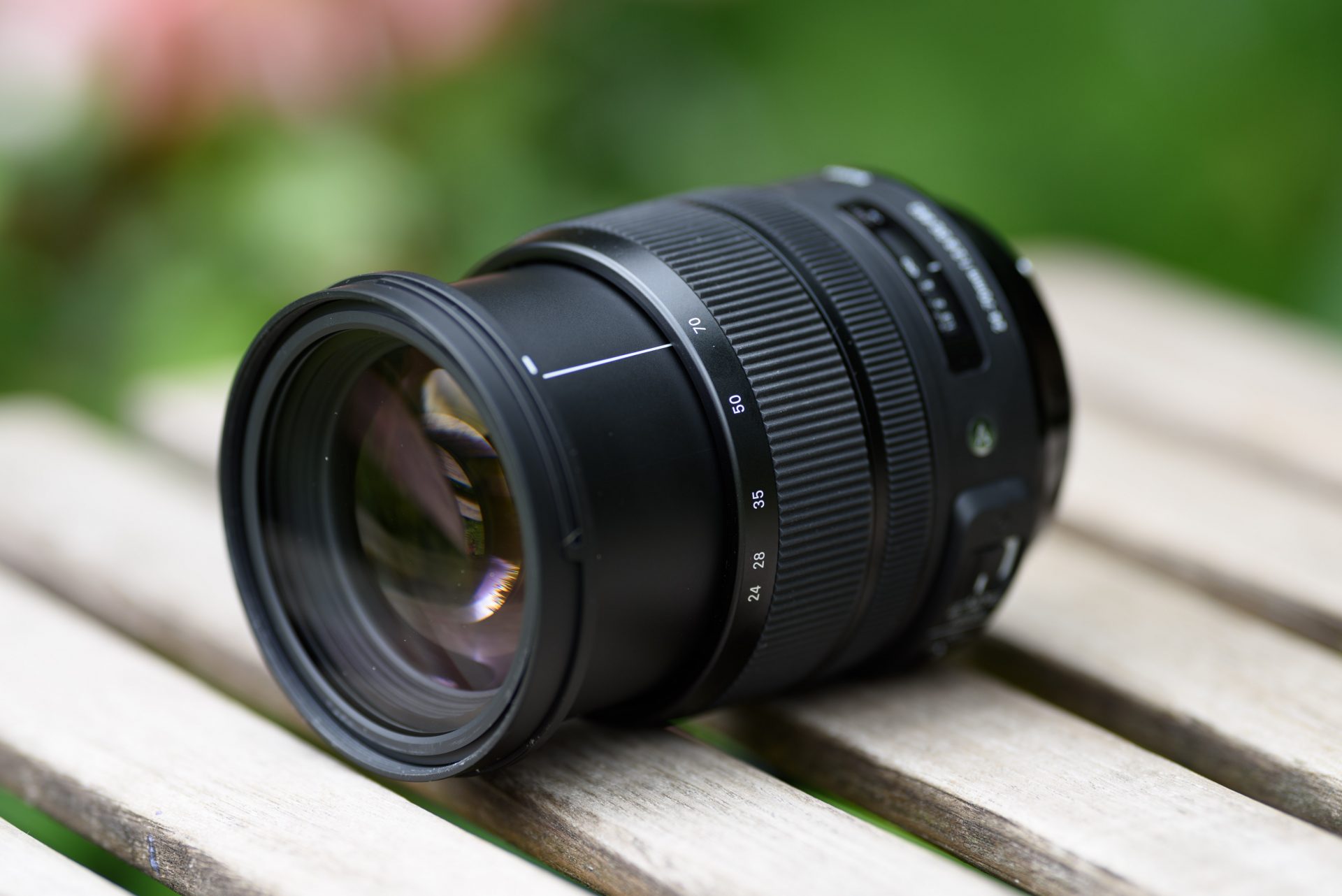
 The Sigma 24-70mm f2.8 OS Art is a standard 2.9x zoom available in mounts for Canon, Nikon and Sigma DSLRs with full-frame sensors, and can also be used with Sony E-Mount bodies using Sigma's MC-11 mount converter. It has a very good image stabilization and is shorter, cheaper, produces less loCA, has a better Bokeh, and shows less vignetting than the reference in its class, the Nikon 24-70/2.8E VR. But its image quality at the short end and in the outer area of a high resolution full-frame senor is disappointing considering that this lens is a member of Sigma's well-renowned "Art"-line. But still the Sigma 24-70/2.8 OS Art earns a recommendation.
The Sigma 24-70mm f2.8 OS Art is a standard 2.9x zoom available in mounts for Canon, Nikon and Sigma DSLRs with full-frame sensors, and can also be used with Sony E-Mount bodies using Sigma's MC-11 mount converter. It has a very good image stabilization and is shorter, cheaper, produces less loCA, has a better Bokeh, and shows less vignetting than the reference in its class, the Nikon 24-70/2.8E VR. But its image quality at the short end and in the outer area of a high resolution full-frame senor is disappointing considering that this lens is a member of Sigma's well-renowned "Art"-line. But still the Sigma 24-70/2.8 OS Art earns a recommendation.



